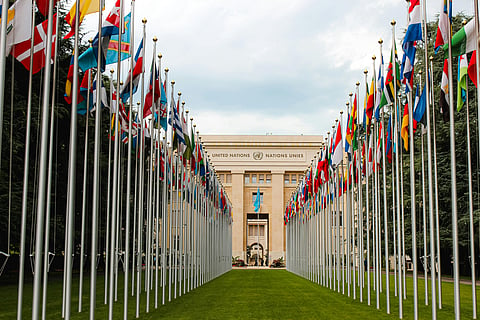

When the Charter of the United Nations came into force on October 24, 1945, the smoke of war still hung over cities from Warsaw to Hiroshima. In the ruined aftermath of the Second World War, with Europe flattened, Asia bleeding, and humanity chastened by its own ingenuity for destruction, fifty-one nations signed their names to a document that was part treaty, part plea. There was exhaustion in the air, and hope.
In the very first line, they pledged “to save succeeding generations from the scourge of war.” They promised to maintain peace, foster equal rights, promote social progress, and harmonise the actions of nations in a new global order.
What has followed across eight decades has been a long experiment in international cooperation within an ever-shrinking world. Advances in technology, trade, and communication bind nations closer than ever before, making the consequences of conflict truly global.
The verdict on the experiment’s success, it turns out, depends on which floor of the UN you’re standing on.
On the upper levels, where diplomats gather and cameras flash, one could be forgiven for thinking that it has failed. The world’s headlines still repeat like old radio static. New wars erupt. Old wounds fester. The business of peace remains ever unfinished.
The Security Council now too often resembles a stage for stalemate. In the council’s great chamber, resolutions are tabled and torpedoed. Words multiply, and yet action thins. Ukraine, Gaza, and Sudan come to mind. It seems as though the locations change, while the impasse does not.
The world entrusted this institution with preventing catastrophe, and the record is, at best, uneven. Wars have continued, often in defiance of the UN’s very existence, and at times it has been reduced to documenting conflict after the fact. Its voice, once resonant in 1945, now competes with the din of media cycles and digital disinformation. From this vantage, the organisation can seem every bit its age — slow, tired, and increasingly peripheral.
But to stop the account there is to misunderstand the full architecture. Below the chamber of speeches lies a quieter, more enduring story. The United Nations that persists while the headlines turn sour is one that lives in the margins of crisis, not in debate.
Consider the reach. From fifty-one founding members, the UN now counts 193 countries, which is almost every sovereign nation on earth. Its system encompasses the World Health Organisation (WHO), the World Food Programme (WFP), the United Nations Children’s Fund (UNICEF), the United Nations High Commissioner for Refugees (UNHCR), and dozens more.
Together, these agencies serve the Charter’s larger purpose: “to promote the economic and social advancement of all peoples.”
Over the decades, the UN has mounted peacekeeping missions on nearly every continent — barring Antarctica, of course — with more than two million men and women having worn the blue helmet.
In 1980, smallpox, the most lethal disease in human history, was declared eradicated after a global vaccination campaign spearheaded by the WHO. The World Food Programme feeds tens of millions every year, often in places the world prefers to forget. UNHCR has helped tens of millions displaced by war and disaster. UNICEF has driven down child mortality and kept the basic machinery of survival running in zones of collapse.
This is a different kind of peacekeeping, one that is patient and granular. Even now, as cynicism has become the world’s lingua franca, these operations persist. When a flood sweeps away a village, or a war uproots a city, the first to arrive, and often the last to leave, are the anonymous mechanics of the UN’s system.
While it is true that the founding dream of one world governed by rules, reason, and conscience, remains incomplete, it is worth asking what the world would look like in the absence of the United Nations. It is possible, perhaps even probable, that the age would be darker still.
We should remember that the United Nations, as an organisation, is not “the solution” to all that is bad in the world. Indeed, it is not a solution at all. What it is, instead, is a scaffold. An imperfect tool for countries to negotiate, coordinate, and sometimes merely perform civility, in a relentless effort to broker a better tomorrow.
The UN’s greatest achievement, then, might be the infrastructure it has built of peacekeepers, humanitarian corridors, immunisation drives, schools rebuilt, and data gathered. If the institution seems weary, the problem is not with the attempt, but with the world’s appetite for better alternatives.
We can deride its inefficacy, or we can acknowledge that abandoning it would be to accept a world stripped even of the pretence of order, rules, or a common vocabulary for peace.
